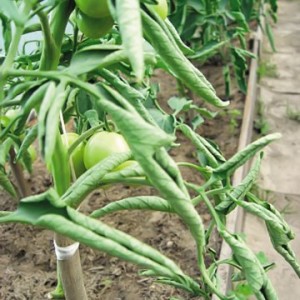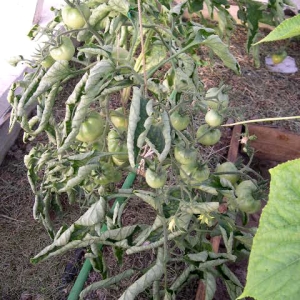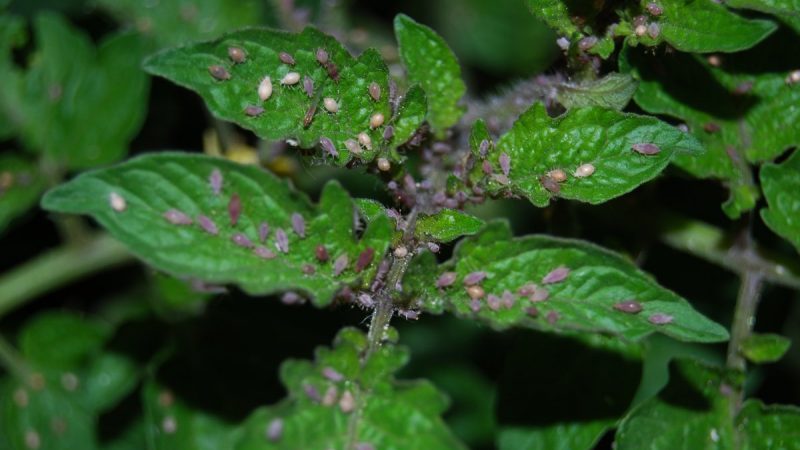What to do if tomato leaves curl in a greenhouse?
Often, the leaves of tomatoes planted in a polycarbonate greenhouse begin to curl. They curl up, curl up, or go down. By the different position of the tomato leaves, you can understand what mistakes the grower made in the care.
The content of the article
The main causes of twisting
Depending on the reason for the change in the shape of the leaves, a treatment strategy is chosen. It is possible to determine the source of infection by examining the nature of damage to leaves, tomato stems, soil around plants.
Improper pinching or pinching of tomatoes
Leaves can curl up or down. This is due to stress on the plant if too many stepsons or large shoots are removed.
Important! With improper pinching, the yield will decrease.
Overdose with organic fertilizers
After excessive feeding with fresh manure, the following can occur:
- root damage due to ammonia burns;
- an excess of nitrogen - the stem becomes thick, the leaves are dense, the bush itself is dark green, the upper leaves of the plant curl down into a ring;
- phosphorus deficiency - the edges of the leaves turn up, then bend down, become dark with purple streaks, the bush grows slowly, the stem becomes fragile.
Violation of watering rules: underfilling and overflowing
If the edges of the leaf blades curl downward, this is a signal of a lack of moisture. In this case, the leaves become soft and lethargic.
If the fragile leaves curl upward in an attempt to increase evaporation, this indicates an excess of moisture.
Root damage
In case of improper transplantation of a plant into open ground, mechanical damage to the roots occurs. Leaves curl along their entire length and go down.
When the roots are damaged by underground pests (bear, wireworm larva, gall nematode), tomato leaves twist into a ring and go down.
How to recognize root pests:
- Medvedka - holes and tunnels up to 2.5 cm are visible in the ground;
- the larva of the wireworm beetle eats holes in the roots and crawls inside the stem;
- root nematode - swellings and nodules form on the roots.
Tomato infections
Warm greenhouse conditions are characterized by:
- Bacterial cancer... It appears when the humidity in the greenhouse is more than 80% daily, there is not enough light for tomatoes, too much moisture, and a constant temperature is above + 25 ° C.

How to find out? The plant turns yellow, the edges of the leaf blades curl on one side, the other retains its original shape. In the middle tier of the plant, ulcers, necrotic spots appear, the leaves dry, but do not fall off, the stem cracks, yellow mucus flows from the cracks, its core turns yellow, and the fruits are covered with white spots. - Tobacco mosaic Is a virus that infects tomatoes with a small amount of light, poor ventilation of the greenhouse, dense planting of plants, excessive watering and humidity of more than 80%.
The leaves of the plant are completely twisted, covered with yellow spots, swell, and the fruits stop growing. - Verticillary wilting - a fungal disease that occurs after excessive watering of dried soil and when the temperature drops to 20 ° C and below. Young tops of tomatoes curl inward with edges, turn yellow and dry, the stem becomes light brown on the cut, its necrosis develops and the roots die off.
Pests
Pests infect tomato leaves, feed on their juice, and most often settle on the back side:
- Potato aphid - small insect of red or green color. Drinks juice from young leaves at the top, which makes their edges curl up. On tomatoes - sticky spots from aphid honeydew.

- Whitefly - white midge, flies away from the bush when a person approaches it. Tomato juice is drunk by whitefly larvae, similar to gray specks of dust that stick around the entire bush. The leaves become lethargic, pale yellow spots are visible around the bites, and under them are dark and light sticky spots. What to do with tomatoes while rolling the leaves upside down? Fight the whitefly.
- Spider mite... His presence explains why tomato leaves curl inward in the greenhouse. In this case, the lower leaves of the plant suffer. Over time, ticks form a whole web, and the surface of the leaf is covered with white or colorless areas.
Elimination of causes and prevention of twisting
When twisted leaves are found on tomatoes, the first step is to adjust the growing conditions for the crop. Tomatoes are demanding on the rate of watering and dressing, every mistake in care can critically affect the yield.
| Twisting reason | How to fix | How to prevent |
| Wrong pinching or pinching | Plants feed nitrogen, phosphorus or potash foliar fertilizers. | Stepsons are removed on time and according to the scheme prescribed for a particular plant variety. It is optimal to break off 2-3 sheets per week, and break off the stepsons until they reach 5 cm.
|
| Overdose of organic fertilizers | Excess nitrogen can be eliminated by adding potassium sulfate (8-10 g per 1 m²) or ash (50-80 g per 1 m²) to the soil. To flush nitrogen from the soil, tomatoes are watered abundantly. Stepchildren who have reached 12-18 cm are removed. With a lack of phosphorus, they are fed with superphosphate according to the scheme indicated in the instructions. |
Fresh manure, even multiply diluted with water, is dangerous for the plant during root feeding. Tomatoes are fertilized with special preparations suitable for the variety, soil, climate, growing conditions.
|
| Breaking the rules glaze: underfilling and overflow | If the plants are lacking moisture, you need to start watering - every day in small portions. If overflow is allowed, stop irrigation for 1-2 weeks |
Tomatoes love moisture. Young plants that have just been planted in the ground are watered in small volumes 2 times a day until complete rooting. After that, watered 1-2 times a week. When the bushes have faded and fruits have begun to set, watering is increased as for young plants. The rest of the time - do not pour under the bush. Warm, settled, preferably well, water spray drip, in moderate portions |
| Mechanical damage to roots | The bushes are fed with phosphorus fertilizer by spraying to stimulate the root system | Careful transplantation of the plant into the ground. Method: pour a tomato in a pot with water, carefully remove it and transplant it into the prepared hole.
Rooted tomatoes are loosened without touching the roots. |
If there are no violations of agricultural technology, and damage on the leaves indicates the presence of a disease or pests, medical and preventive measures are taken.
| Name of the disease or pest | How to fix |
| Bacterial cancer | Not treated. The bushes are dug up and burned. Uninfected tomatoes are treated with copper preparations: Bordeaux liquid, copper chloroxide or copper sulfate. The best time for processing is from 10 am to 12 pm or from 4 pm to 6 pm. |
| Tobacco mosaic | Also not amenable to treatment. You can help a tomato by removing the affected leaves to healthy tissues. So that the disease does not touch healthy bushes, they are treated with milk whey (solution for dilution with water 1: 1). Spraying is carried out every week, even after the fruit has ripened. |
| Verticillary wilting | The infected plant is dug up along with the root and burned.The soil where the affected tomato grew is replaced. So that the rest of the plants do not get sick, they are sprayed 2 times with an interval of 10 days with an aqueous soap-ash mixture.
To prevent the leaves of the plant from curling due to verticillary wilting, foliar feeding is carried out - 2 g of zinc sulfate, 3 g of boric acid, 5 g of magnesium nitrate per bucket of water. Spray this mixture 3 times after 15-20 days. |
| Potato aphid | The leaves affected by aphids are removed, the plant is doused with water to wash off the remaining insects. For small lesions, wipe the leaves with soapy water or spray with bioinsecticides: "Akarin", "Bitoxibacillin".
In case of large lesions, they are treated with chemicals: Trichlormetaphos, Aktara, Biotlin. Folk recipes are used. Tobacco infusion: 400 g of dried tobacco leaves are cut, poured with 1 bucket of boiling water, insisted for 5 days. Herbal decoction (one of your choice): yarrow, wormwood, marigolds, chamomile, celandine, dandelion. Pour 1 liter of boiling water with 500 g of chopped green parts of the plant and boil for 20 minutes. Insist 2 days and spray the affected leaves |
| Whitefly | With small lesions, it is better to fight it with biological agents: "Verticillin", "Boverin". You can add macroflorus, encarzia or amblyseius, that is, predatory insects, to the greenhouse. Fumigation of plants with tobacco sticks is suitable: 3 times in 10 days. In case of extensive lesions, they are sprayed with insecticides: "Actellik", "Tanrek", "Inta-Vir" |
| Spider mite | The leaves affected by the mite are removed. Wipe or spray tomatoes with soapy water or horseradish infusion. The bucket is 1/3 filled with chopped shoots and horseradish leaves, poured to the brim with water, an hour later, the tomatoes are filtered and sprayed. Repeat after 12 days.
Special biological products that kill the tick: Fitoverm, Kraft. Chemicals: Oberon, Borneo. Apollo |
| Medvedka | The bear eats up the roots of the plant, so it will not work to revive them. They fight the pest with granular baits: "Medvetox" or "Thunder" |
| Wireworm | The wireworm is removed by adding a low-borne solution of potassium permanganate under the bush. From chemicals take granules "Diazolin 10-RG", "Provotox" or "Bazudin". |
| Gall nematode | Damaged plants die. They are dug up and destroyed. Bushes from this pest are not treated. After harvesting, the soil is changed in the greenhouse. |
Outcome
There are many reasons why the leaves of tomatoes in a greenhouse can curl. In search of the source, you will have to analyze each bush, carefully examine the damaged leaves, and look into the root system. Having identified the problem, it remains to act according to the recommendations for the treatment of tomatoes, so as not to lose the crop.